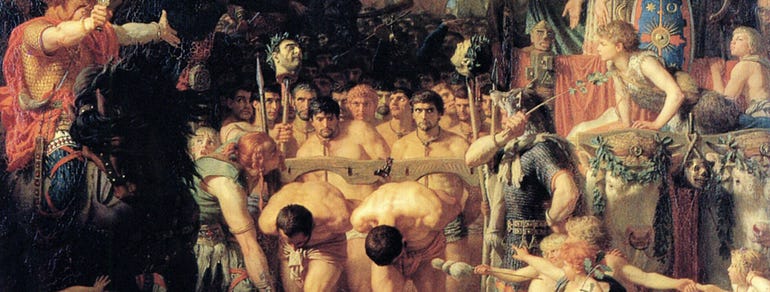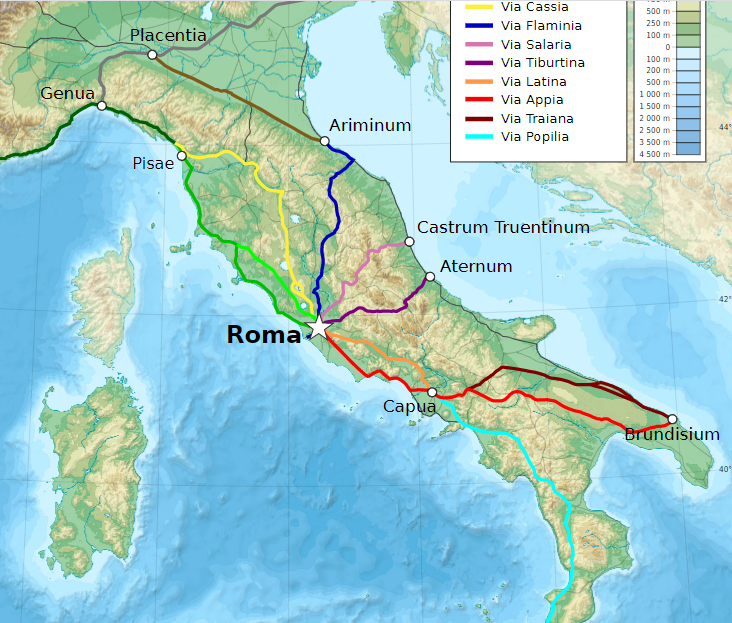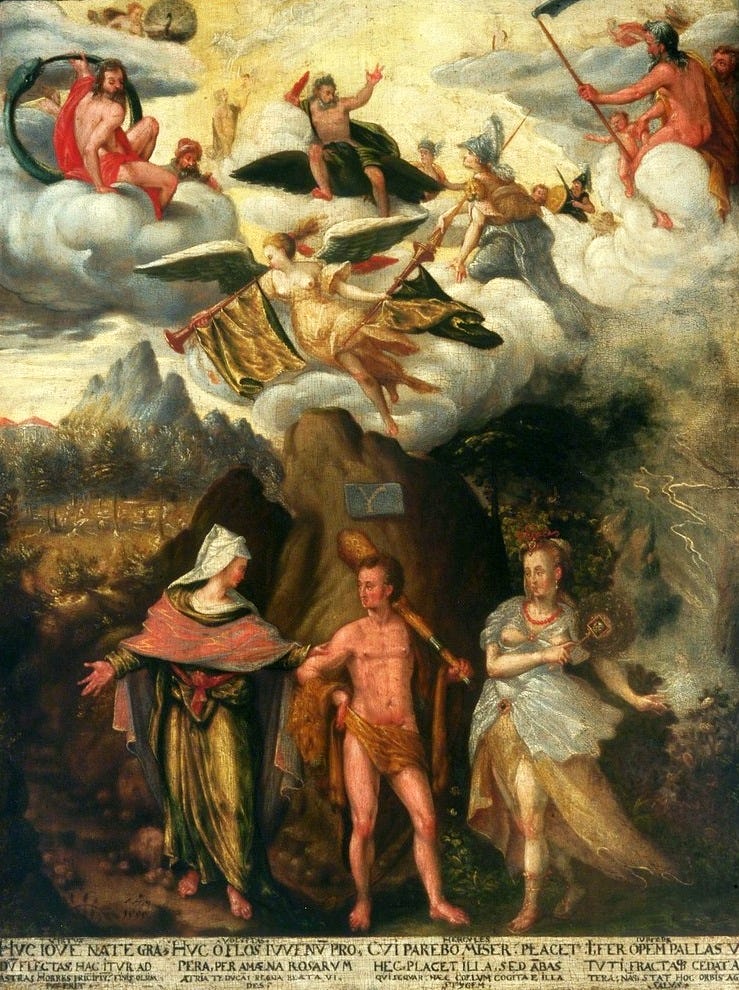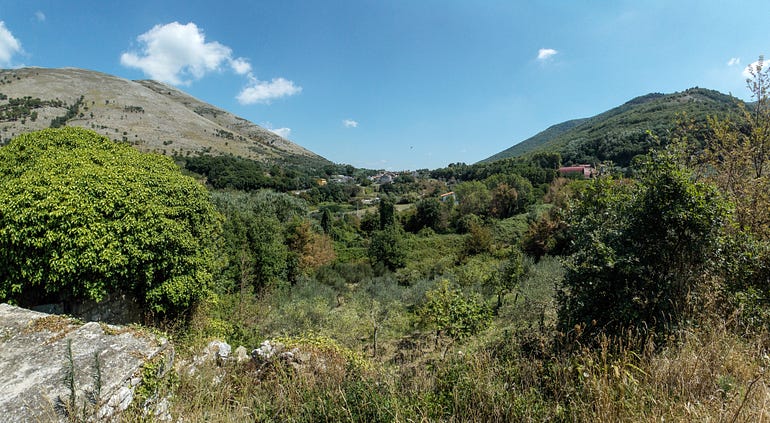There Are No Caudine Forks
A New Solution To A Classical Problem

In the ninth book of Livy’s Ab Urbe Condita, Livy describes the most memorable event in the history of the Samnite Wars, and one of the most notable disasters in Roman military history: the Battle of the Caudine Forks (321 B.C.). Livy himself had in the previous book complained, writing about the Samnite wars, that there were no authors contemporary with these events of any reliability (Nec quisquam aequalis temporibus illis scriptor exstat, quo satis certo auctore stetur), and that the historical record had been made useless (vitiatam memoriam… reor) due to Roman families trying to burnish their reputations. The Battle of the Caudine Forks is one of the most interesting such cases. Serious historians agree that Livy’s version — in which the Romans, ambushed in a location so tactically disadvantageous that they surrender without a battle — is not likely to represent what actually happened. Not only would common sense suggest that at least some fighting took place, Cicero says as much in both of his notices of the event. In the De Officiis (3.109) he describes the consuls suing for peace cum male pugnatum apud Caudium esset; in the De Senectute (41) he describes them as Caudino proelio superati, which indicates contention. Explaining how the historical memory got vitiated in the instance of Livy’s version is tortuous but not impossible: both tactical positioning and surrender are the responsibility of commanders, and in this instance Livy’s version seems to want to absolve the Roman soldier and pins all the blame on the leaders, who were sent off to the Samnites when the Roman senate refused the terms and returned paroled soldiers to the battle ranks.
But there is an additional mystery in the story. Livy offers a rather insistent, rather remarkable description of the Caudine Forks, the setting of the battle/surrender. Unfortunately, despite quite a bit of searching, no one has been able to locate any place which matches the description. What is going on here? Why would a historian give a detailed description of a place that does not exist? The commentators and scholars have all made suggestions, but their suggestions all vary somewhat because no one seems to have a convincing argument for what is happening in Livy’s text. I think I have a better solution.
Let’s quickly take a look at the description Livy offers us:
Duae ad Luceriam ferebant viae, altera praeter oram superi maris, patens apertaque sed quanto tutior tanto fere longior, altera per Furculas Caudinas, brevior; sed ita natus locus est: saltus duo alti angusti silvosique sunt montibus circa perpetuis inter se iuncti; iacet inter eos satis patens clausus in medio campus herbidus aquosusque, per quem medium iter est; sed antequam venias ad eum, intrandae primae angustiae sunt, et aut eadem qua te insinuaveris retro via repetenda aut, si ire porro pergas, per alium saltum artiorem impeditioremque, evadendum.
Two roads led to Luceria, the first along the Adriatic shore, flat and unobstructed, but as it was the safer, so it was also the longer. The other through the Caudine Forks — shorter. But this is what the place is like: two mountain passes, high, narrow, and wooded, are joined by a chain of mountains with no break between them; between these passes is an enclosed plain, flat enough, grassy and well-watered, through the middle of which goes the route. But before you get to the plain, you must enter the first defile, and you must either leave by the same route you made your way through, or, if you continue straight, you must come out via the other pass, even more narrow and difficult. (9.2)

In eum campum via alia per cavam rupem Romani demisso agmine cum ad alias angustias protinus pergerent, saeptas deiectu arborum saxorumque ingentium obiacente mole invenere. Cum fraus hostilis apparuisset, praesidium etiam in summo saltu conspicitur. Citati inde retro qua venerant pergunt repetere viam; eam quoque clausam sua obice armisque inveniunt.
As the Romans proceeded on the one road [the road into the enclosed valley] out of formation, through a hollow gorge straight into the plain to the other defile, they found the defile blocked by downed trees and an obstructing wall of huge rocks. When the enemy’s stratagem was clear, a garrison at the head of the pass is also spotted. With quickened step they return the way they came; they find it blocked by its own barrier and by soldiers. (9.2)
So the geography of the battle is as follows: the Samnites have occupied the two extremes of a valley, which both are safe positions, while the Romans are caught in the middle, which is a disadvantageous position. In fact, Livy claims that the position was so disadvantageous that the Romans never attempted to fight, reasoning with themselves like this:
Quo aut qua eamus? Num montes moliri sede sua paramus? Dum haec imminebant iuga, qua tu ad hostem venias? Armati inermes, fortes ignavi, pariter omnes capti atque victi sumus. Ne ferrum quidem ad bene moriendum oblaturus est hostis; sedens bellum conficiet.
Where will we go? And how will we get there? We’re not going to try to move the mountains from their seats, are we? As long as these ridges loom over us, how will you even get at the enemy? Armed and unarmed, the brave, the cowards, we are all equally captured and conquered. The enemy isn’t even going to offer his sword so we can die properly; he will finish the war just by sitting. (9.2)
And that is, according to Livy, what happened: the Samnites simply let the trapped Roman army sit in the enclosed valley. The Roman army capitulated without fighting.
The problem, as I have noted, is that there is no place on the ground which corresponds with this description. The route of the Via Appia — and Livy does say that the Roman army was following one of the standard routes — does not feature any mountain passes which could be blocked so quickly and so effectively to entrap an entire Roman army (which was capable of laying siege to walled cities whose fortifications were much more formidable than anything that could be thrown up in a few hours). The mountain pass between Campania and Samnium, near the town of Arpaia, is the traditional site of the battle (there is even an Italian village named Forchia there), and the late Nicholas Horsfall, a scholar who took great interest in topography in Roman history, puts the battle there though he notes that there is only one mountain pass, not two, and that pass has a gentle slope and is never less than a third of a mile wide. An army might block and hold it, but could hardly entrap anyone there: an approaching army could choose to attempt to storm the pass, or go around via any of the secondary routes into the Caudine Valley which exist.
Stephen P. Oakley, in his commentary on the second pentad of Livy (2005), offers the scholarly synthesis on this passage:
The real problem with the pass between Arienzo and Arpaia is that it is not easy to see how the Samnites could have blocked the western exit [the approach from Rome], especially when the Romans had just passed through it. One may wonder why the Romans did not charge down the gentle slope and escape. For at no point do the hills really narrow into what might be termed angustiae. Indeed, were Livy’s narrative to be taken seriously, this would be the major unsolved topographical problem of the Caudine Forks. It is difficult, however, to see how Livy’s story (and in particular the puzzling blocking of the exit through which the Romans had just passed) can be wholly reliable, and the probability that the Caudine Forks lay between Arienzo and Arpaia is one of the factors which makes one question the traditional story that the Romans were surrounded in the pass.
So if Livy’s version is not based on military facts — if the Romans were never actually caught in a plain between two mountain passes — what is Livy doing? Here is Oakley’s answer:
Livy, like most writers of his day, was trained in rhetoric, and practice at scenic description was an early and important part of this training. Rhetoric demanded that descriptions should be “plausible.” Modern writers often strive for plausibility by producing a host of details apparently unique to the place or phenomenon being described; but the ancients preferred to use standard and stereotyped ideas which conformed to their readers’ general expectations, which they varied to achieve some measure of originality and individuality. Therefore Latin writers tend to describe in a stylized and literary way rather than accurately record all that they observed with their own eyes.
He goes on to list four aspects of the description which he finds stereotyped and stylized: 1) a pass made up of mountains and woods 2) the adjective “cava” (hollow) referring to the site 3) “a wide plain surrounded by hills is a stereotype” 4) running water and grass.
Even Oakley acknowledges that these make a pretty thin argument: woods, mountains, hollows, plains, grass, running water, hills, are basic features of Mediterranean landscape, not evidence of rhetorical training:
Appearing on its own, none of these features would have much significance: for example, although green grass and running water are features of the locus amoenus, they are often found naturally in Italy and Greece. Cumulatively, however, they point decisively to Livy’s having freely composed this description according to literary canons.
The problem with this reasoning is that this description is not stereotyped: it is in every way based on “details unique to the place or phenomenon being described”: we have a sequence of narrow pass — grassy enclosed valley — narrow pass. There isn’t any other such place in all of the literature. Its uniqueness is precisely the reason why it can’t be located on a map. And what’s more, the unique nature of the site is the major causal determinant of the outcome of the battle.
Horsfall’s conclusion in his article “The Caudine Forks: Topography and Illusion,” is that reading Livy’s account as factual in a military sense is “quite fruitless.” But his various suggestions show he has no particular answer to the problem of why this description is so erroneous. He suggests, as Oakley does, that we might need “to credit the author’s fertile imagination with topographical details;” he also asserts that Livy, when it comes to geography, is “the prisoner of ignorance and convention.” He furthermore suggests literary contamination, though he finds no particularly notable parallels:
It remains to suggest that Livy’s imagination may at this point also be straying to East; certainly he is exercised by the simultaneity of the second Samnite War with the campaigns of Alexander, and synchronism prompts contamination.
In other words, perhaps there is some unknown Greek story of being caught between two mountain passes, which served as a model.
But there is a much better answer than all these. The interpretive key is found in the sequel to the initial capture.
Once the Romans are trapped, the Samnite general, Gaius Pontius, is overwhelmed by his good fortune. He feels uncertain about letting the Romans trapped in the pass die, whether by starvation or massacre; and so he sends for counsel to his father, Herennius Pontius, esteemed the wisest of the Samnites:
Is ubi accepit ad Furculas Caudinas inter duos saltus clausos esse exercitus Romanos, consultus ab nuntio filii censuit omnes inde quam primum inviolatos demittendos.
When the man had heard that the Roman armies were trapped between two passes at the Caudine Forks, upon being asked by his son’s messenger he declared that all the Romans were to be set free at once without being harmed.
This sort of clemency seemed like such a militarily unsound opinion that the Samnites sent to Herennius a second time, who responds with a new counsel: kill every single man in the pass. Herennius was then brought to the site in person, where he explains his reasoning:
Priore se consilio, quod optimum duceret, cum potentissimo populo per ingens beneficium perpetuam firmare pacem amicitiamque; altero consilio in multas aetates, quibus amissis duobus exercitibus haud facile receptura vires Romana res esset, bellum differre; tertium nullum consilium esse.
By his first plan, which he considered the best, they would establish peace and friendship with a very powerful nation, by doing them a great good deed; by his second plan they would put off the war for many generations, during which the Roman Republic would with difficulty recover its strength after the loss of two whole armies; there was no third plan. (9.3)
Neither of his plans is accepted, and the Samnites decide on a middle course: they disarm the Romans, humiliate them by making them pass under the yoke, extract a promise that the Romans will abandon their colonies in Samnite territory, and send the Romans home, considering the war over. The Roman senate ends up abjuring the treaty negotiated by the consuls, rearming its troops, and defeating the Samnites in a subsequent battle. By taking a middle course, the Samnites had thrown away their opportunity.
In sum: general seeks advice; is given the advice to be absurdly generous to his enemy; refuses the advice; then is advised to be ruthlessly murderous, and he refuses that as well. He then crafts a hybrid approach, which ends up bringing disaster on his people. What do we have here? We have a moralizing lesson about the dangers of moderation. Herennius supported either extreme: either overwhelm the enemy with generosity or be utterly merciless; otherwise there is tertium nullum consilium. This is a most unusual lesson from the ancient world, which in general prized moderation; but in war as in other things, there are situations when there are only safe options are the extreme ones; to be in the middle is the worst option of all. And the topography of the story is this same lesson in geographical form. The Samnites occupy the two extreme points of the valley, and are safe. The Romans are caught in the middle, which is to lose. The Samnites let the Romans out and themselves take a middle position, which brings an equal disaster on them. The two disasters cancel each other out, and by the end the Romans are in the position they started: favorites to beat the Samnites and become masters of Italy.
As you might expect, Machiavelli, in his Discourses on the First Ten Books of Livy, got the moral of the story perfectly:
But most carefully should we avoid, as of all courses the most pernicious, such half-measures as were followed by the Samnites when they had the Romans shut up in the Caudine Forks, and would not listen to the counsels of the old man who urged them either to send their captives away with every honourable attention, or else put them all to death; but adopted a middle course, and after disarming them and making them pass under the yoke, suffered them to depart at once disgraced and angered. And no long time after, they found to their sorrow that the old man’s warning was true, and that the course they had themselves chosen was calamitous.
Machiavelli did not particularly notice that the geography of the story had been engineered to teach the same lesson, but as far as I know, no one has noticed this until now. As a piece of geography, the Caudine Forks belong with Dante’s Mountain of Purgatory, Bunyan’s Slough of Despond, or Odysseus’s Ogygia: these are symbolic locations that have a moral rather than a geographical meaning. To be caught in the Caudine Forks means to have chosen a middle course when only the extremes are safe.

Perhaps the best — and a Classical — example is Hercules’ Crossroads. Xenophon (Memorabilia 2.1) says that Socrates quoted Prodicus’s story — and yes indeed, the origins of the tale are hence a bit obscure — of Hercules in his youth being accosted by two women, named Virtue and Vice (though to be fair to her, she insists that her name was “Happiness,” but the haters (οἱ δὲ μισοῦντές) called her Vice), when he was wondering whether he should choose the way of virtue (δι᾽ ἀρετῆς ὁδὸν) or of vice (κακίας). In the first version we have of the story, there is very little geography involved — the two women might simply be asking him to decide, as in the Judgement of Paris, and the “way of virtue” might be nothing more than a metaphor. The word “crossroads” never appears. Similarly in Cicero, who virtually translates Xenophon’s words in the De Officiis, the whole is rather abstract. But by the time of Lactantius (Divinae Institutiones 6.3, well worth reading in its entirety) we learn that the “crossroads” notion is now in place, and that philosophers customarily teach that the crossroads looked like the letter upsilon (Y). By the time of Petrarch, Durer, etc. the spatial dimension of the story is established and “Hercules ad bivium” is proverbial. It would become a favorite subject for Western art, and much-elaborated.

What we see in the Caudine Forks story is a completed symbolic topography. Interestingly enough, even the Latin word furca refers (typically; some lexicographers say exclusively) to an item with two prongs, like the tongue of a snake. In other words, it looks precisely like an upsilon (Y), the same image of moral choice used with Hercules. It is presumed that the reason why a mountain pass could be called a furca is because mountain passes also resemble the letter Y, as you pass through the low middle ground with heights to your left and right. The similarities are quite striking. But unlike in the Hercules story, the symbolism never quite caught on. The Caudine Forks should probably be conceived of as a symbolic topography which never quite reached proverbial status. It could have become proverbial (to be ad Furculas Caudinas, where you must choose one of two extremes but not a middle course)— the story is really quite excellent at conveying the danger of the middle course — but it never did.
How did this moralizing topography end up in Livy? Did he “freely compose” it, as Oakley suggests? I doubt it, as it is not typical of Livy’s method. Some historicizing fabulizer antecedent to Livy probably dressed up the Caudine Forks story as an anti-moderation object lesson, combining the insight of Machiavelli with the topographic imagination of Dante. Livy probably found this version, and with his usual eye for the romantic and morally valuable, preferred it to whatever drier, more factual, less meaningful versions he may have had at his disposal. It may contain a kernel of historical truth: the Samnites, after a great victory, may well have thrown away their victory by their moderate treatment of the vanquished. That kernel was taken by an imaginative writer, and fitted out as an anti-via-media fable, complete with a fabulous geography.
For my part I am glad that Livy has preserved this version for us, even if historians have been cracking their heads trying to make history of it. It reads well, and I have used it with students, asking them to explain Livy’s symbolic geography here, which all of them can see as soon as they are directed to look for it. I consider it valuable training in reading fictional landscapes, and an excellent lesson in how the uniquely Roman mythology works. As everyone knows, the Romans took much of their religious narrative inspiration from the Greeks; but what students (and apparently even scholars) often miss is how much mythological material is concealed under the guise of Roman history. Even factual occurrences begin to take on mythic elements if they are felt to have meaning — Alexander’s early death, or the sinking of the Titanic are good examples of facts with a mythic dimension — and Roman history abounds in such examples. And plenty more pure myth and fiction got stuck in the annals and taken for fact. I would trust the details of this story no more than I would trust that a man named Hercules was actually approached by two females named Virtue and Vice. But the mythic dimension elevates narrative, and makes it a fit subject for reflection. It’s interesting to think of the situations where moderation, that most plausible virtue, becomes a self-destructive vice. These are the kind of questions you can ponder with Livy and Plutarch, and this is why they sometimes make better reads than more sober chroniclers. And that is why we should be careful not to be too eager to make history — much less cartography — out of the Roman historians.
John Byron Kuhner is the former president of the North American Institute of Living Latin Studies (SALVI) and editor of In Medias Res.
Sign up to receive email updates about new articles


Comment
Sign in with